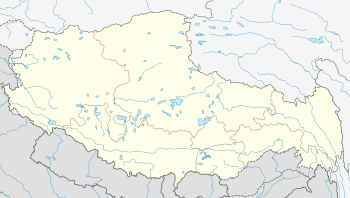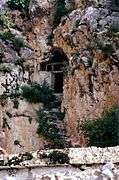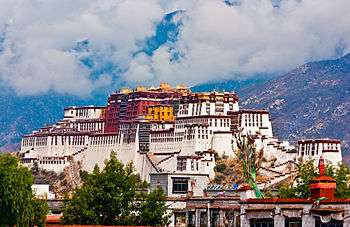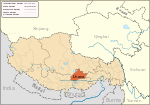Yerpa
| Yerpa | |
|---|---|
|
Monastery ruins, 1993 | |
| Tibetan transcription(s) | |
| Tibetan | གཡེར་པ |
| Wylie transliteration | g•yer pa |
| Pronunciation in IPA | [[jeːpa]] |
| Official transcription (China) | Yêrba |
| Chinese transcription(s) | |
| Traditional | 葉巴 |
| Simplified | 叶巴 |
| Pinyin | Yèbā |
 Yerpa Location within Tibet | |
| Coordinates | 29°44.87′N 91°16.83′E / 29.74783°N 91.28050°ECoordinates: 29°44.87′N 91°16.83′E / 29.74783°N 91.28050°E |
| Monastery information | |
| Location | Yerpa Valley, Lhasa Prefecture, Tibet, China |
| Founded by | Songtsen Gampo and Trisong Detsen |
| Founded | 7th-8th century |
| Type | Tibetan Buddhist |
| Sect | Gelug |
Yerpa (also known as: Brag Yer-pa, Drak Yerpa, Druk Yerpa, Dagyeba, Dayerpa, and Trayerpa), is only a short drive to the east of Lhasa, Tibet, and consists of a monastery and a number of ancient meditation caves that used to house about 300 monks.[1]
Description
Dra Yerpa is located on a hillside in Dagzê County.[2] The entrance to the Yerpa Valley is about 16 kilometres (9.9 mi) northeast of Lhasa on the northern bank of the Kyichu. From there, it is another 10 kilometres (6.2 mi) to the famous ancient meditation caves in the spectacular limestone cliffs of the Yerpa Valley (Tibetan: བྲག་ཡེར་པ་, Wylie: Brag Yer-pa). There is an ancient sky burial site opposite the main caves.
The famous legendary hero Gesar of Ling is said to have visited the valley. The holes his arrows left in the cliffs are believed to be evidence of his presence.
History
Early years
There are a number of small temples shrines and hermitages and the cliffs contain some of the earliest known meditation sites in Tibet, some dating back to pre-Buddhist times. Among the more famous are those traditionally connected with Songtsen Gampo (604–650 CE), (traditionally the 33rd king of the Yarlung Dynasty and first emperor of a united Tibet). His Tibetan queen, Monza Triucham, founded the Dra Yerpa temple here.[3]
He and his two foreign-born queens are said to have meditated in the 'Peu Marsergyi Temple' and in the 'Chogyel Puk', and to have discovered 'self-originated' symbols of the Buddha-body, speech and mind. Padmasambhava, or Guru Rinpoche (late 8th to early 9th century), meditated and practiced tantric yoga with his yogini Yeshe Tsogyal here, and to have spent 7 months in meditation in the 'Dawa Puk', which is considered to be one of his three most important places of attainment.[4] After Lhalung Pelgyi Dorje assassinated the anti-Buddhist Bon Emperor Langdarma in 842 CE he is said to have hidden himself in a cave and meditated for 22 years. His hat was kept there until 1959.[1][5][6]
Yerpa became one of the three most important centres of meditation and retreat in Central Tibet. Several of Guru Rinpoche's disciples are also said to have meditated here. Atisha (982 – 1054 CE) preached extensively in the valley.[7] Atisha's hermitage is in ruins but had 300 monks in the 19th century and was the summer quarters for the Ramoche Monastery (the Upper Tantric College).[4]
Later histories record that both Songtsen Gampo and Trisong Detsen (756–797) founded temples at Yerpa, and Klu-mes Tshul-khrims did some refurbishing in the 11th century.[8][9] Tradition says that after Songtsen Gampo's only son, Gungri Gungsten, was born to Mangza Tricham, Princess of Mang, one of his wives: "A shrine and a stupa dedicated to the tutelary deity of mother and son were built upon the lap of a rocky mountain that resembled a seated image of the Holy Tara in the region of Yerpa."[10]
Gelug control
The ancient Kadampa gompa Yerpa Drubde passed to Gelug control after the reformation of Je Tsongkhapa (1357–1419).[11] After the death of the 4th Dalai Lama (1589–1617), in 1618 the monks of the Gelug monasteries of Sera and Drepung revolted against the Tsangpa forces in Lhasa. Those who were not killed took refuge in Taglung, to the northeast. Khöntön Rinpoché, who had tried to persuade the monks of Sera to avoid violence, moved to Yerpa until calm returned.[12] Yerpa lost its wealth at this time, and was placed under the jurisdiction of Taklung Monastery.[13]
Recent years
| Part of a series on |
| Tibetan Buddhism |
|---|
 |
|
Practices and attainment |
|
History and overview |
|
There were some 300 monks living at Yerpa from at least the beginning of the 19th century until 1959. It also acted as summer residence for the Gyuto Lhasa Tantric College.[11] The Drubde monastery, the summer residence of the Gyutö College, was destroyed in 1959.[14] During the Cultural Revolution (1966–76) the whole complex at Yerpa, including the Drag Yerpa monastery and the Upper Tantric College summer residence, were completely destroyed.[15]
Using voluntary labor and donations some of the cave temples and Drag Yerpa were later partially restored.[15] Police came to Yerpa after the disturbances of October 1987 and pasted notices on the temple doors warning people against taking part in "counter-revolutionary activities".[15] In 1998 the government demolished a number of chapels that had been built without authorization. The number of monks allowed at Yerpa was still strictly controlled in 2008.[14]
- Yerpa, 1993
 Entrance to Dawa Puk, Guru Rinpoche's cave
Entrance to Dawa Puk, Guru Rinpoche's cave Self-originated sacred symbol
Self-originated sacred symbol A statue of Emperor Songtsän Gampo in his meditation cave at Yerpa
A statue of Emperor Songtsän Gampo in his meditation cave at Yerpa- Statue of Guru Rinpoche in his meditation cave at Yerpa
- Yerpa Valley
- Gesar's arrow holes. (Click to view the holes in the mountains).
- Sky burial site, Yerpa.
 Drak Yerpa valley in Tibet
Drak Yerpa valley in Tibet Drak Yerpa
Drak Yerpa
Footnotes
- 1 2 Osada, Allwright & Kanamaru 2000, p. 99.
- ↑ Historic Dra Yerpa Temple in Tibet, Xinhua.
- ↑ Dorje 1999, pp. 68–69.
- 1 2 Dorje 1999, p. 141.
- ↑ Dowman 1988, p. 75.
- ↑ Gyaltsen 1996, p. 266.
- ↑ Dowman 1988, pp. 73, 79.
- ↑ Richardson 1985, p. 144.
- ↑ Ancient Tibet 1986, pp. 314–315.
- ↑ Gyaltsen 1996, pp. 188–189.
- 1 2 Dowman 1988, p. 79.
- ↑ 14th Dalai Lama, Lhundrub & Cabezón 2011, p. 42–43.
- ↑ Shakabpa 2009, p. 329.
- 1 2 Kelly & Bellezza 2008, p. 140.
- 1 2 3 Schwartz 1996, p. 62.
| Wikimedia Commons has media related to Yerpa. |
References
- 14th Dalai Lama; Lhundrub, Khonton Peljor; Cabezón, José Ignacio (2011-05-17). Meditation on the Nature of Mind. Simon and Schuster. ISBN 978-0-86171-628-9. Retrieved 2015-02-26.
- Ancient Tibet: Research Materials from The Yeshe De Project. Dharma Publishing. 1986. ISBN 0-89800-146-3.
- Dorje, Gyurme (1999). Footprint Tibet Handbook (2nd ed.). Bath, England. ISBN 1-900949-33-4. Also published by NTC Publishing Group, Lincolnwood, Illinois, U.S.A. in 1999. ISBN 978-0-8442-2190-8; ISBN 0-8442-2190-2
- Dowman, Keith (1988). The Power-places of Central Tibet: The Pilgrim's Guide. London: Routledge & Kegan Paul. pp. 73–79. ISBN 0-7102-1370-0.
- Gyaltsen, Sakyapa Sonam (1996). The Clear Mirror: A Traditional Account of Tibet's Golden Age. Translated by McComas Taylor; Lama Choedak Yuthok. Ithaca, N.Y.: Snow Lion Publications. ISBN 1-55939-048-4.
- "Historic Dra Yerpa Temple in Tibet". Global Times. Xinhua. 2012-09-10. Retrieved 2015-02-07.
- Kelly, Robert; Bellezza, John Vincent (2008). Tibet. Ediz. Inglese. Lonely Planet. ISBN 978-1-74104-569-7. Retrieved 2015-02-26.
- Osada, Yukiyasu; Allwright, Gavin; Kanamaru, Atsushi (2000). Mapping the Tibetan World. Tokyo: Kotan Publishing. ISBN 0-9701716-0-9. Reprint: 2004
- Richardson, H. E. (1985). A Corpus of Early Tibetan Inscriptions. Royal Asiatic Society. ISBN 0-947593-00-4.
- Schwartz, Ronald D. (1996-01-01). Circle Of Protest. Motilal Banarsidass Publishe. ISBN 978-81-208-1370-0. Retrieved 2015-02-26.
- Shakabpa, Tsepon Wangchuk Deden (2009). One Hundred Thousand Moons: An Advanced Political History of Tibet. BRILL. ISBN 90-04-17732-9. Retrieved 2015-02-26.

